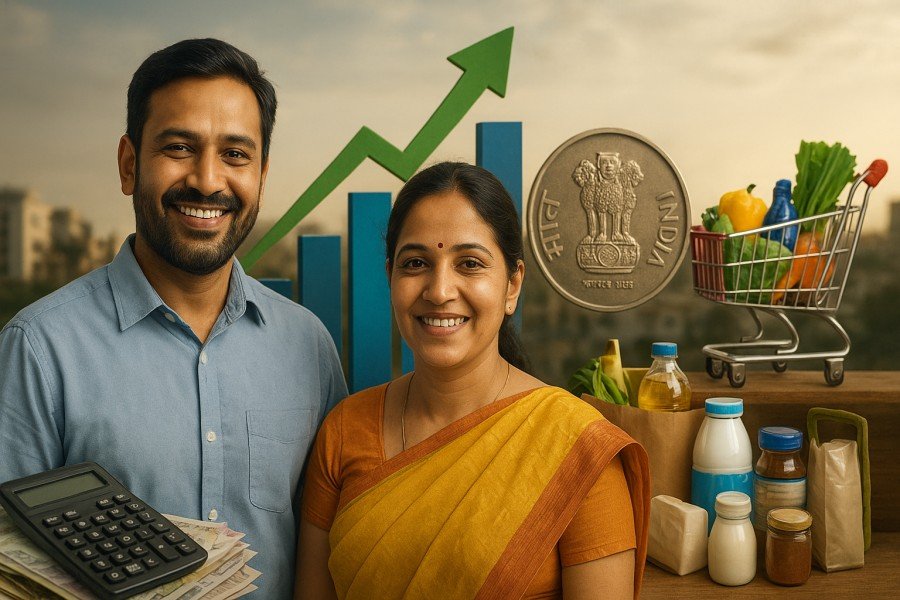India is entering 2025 with one of the most ambitious tax reforms in recent years, and the focus is squarely on the middle class. The Goods and Services Tax (GST), introduced in 2017, was meant to simplify the indirect tax structure, but over the years, it has attracted criticism for its complexity and uneven burden across different income groups. The government’s latest announcement of GST reforms in 2025 promises a significant shift toward easing the financial pressure on ordinary households while still maintaining fiscal balance.
These reforms arrive at a time when inflation, rising living costs, and wage stagnation have left the middle class demanding relief. Let us explore what these changes mean, why they are being hailed as a turning point, and how they may shape India’s economic story going forward.
The Road to GST Reform
When GST was launched, it was considered India’s most significant tax transformation since independence. However, the initial years saw multiple tax slabs, compliance issues, and a perception that the system was not as consumer-friendly as promised. The middle class often bore the brunt of high tax rates on essential services, creating frustration.
By 2023 and 2024, as household savings declined, there was mounting pressure on the government to make reforms. Think tanks, economists, and even state governments pushed for simplified rates and reduced taxation on items of mass consumption. The reforms announced for 2025 are an outcome of this sustained demand for relief.
Key Features of GST Reforms 2025
- Reduction in Tax Slabs
One of the boldest steps is the rationalization of tax slabs. Earlier, GST had five major slabs, ranging from 5 to 28 percent. Under the 2025 reform, slabs are streamlined into three major categories. Essential items fall under the lowest bracket, discretionary goods into the mid-range, and luxury products at the top. This simplification reduces compliance headaches and lowers the tax burden on many everyday products. - Lower Rates on Household Essentials
The government has slashed GST rates on commonly purchased items like packaged food, household appliances, and personal care products. This move directly impacts the middle class, who spend a significant portion of their income on such essentials. - Digital Compliance Made Easier
Taxpayers will now experience simplified return filing through a unified digital system. The reforms emphasize automation, AI-enabled reconciliation, and minimal manual paperwork. This shift is not just about convenience; it also encourages more transparency and reduces the chances of evasion. - Special Incentives for Small Businesses
The reforms also support micro, small, and medium enterprises (MSMEs), which employ millions and indirectly benefit the middle class. With reduced compliance costs and higher exemption thresholds, small businesses can operate with fewer bottlenecks, generating more job opportunities.
Why the Middle Class Stands to Gain the Most
The middle class often feels squeezed between rising aspirations and limited disposable income. For them, GST reforms in 2025 are more than just a policy update they are a much-needed financial breather.
- Affordable Living: With lower GST on essentials, monthly budgets will stretch further. From groceries to utility products, households will feel direct savings.
- Boost to Consumer Confidence: When spending becomes easier, consumer sentiment improves, encouraging families to make larger purchases such as electronics, two-wheelers, or travel packages.
- Better Employment Prospects: With MSMEs getting incentives, job creation will rise, offering more stability for middle-class professionals.

Political and Economic Implications
The reforms are not only about economics but also about politics. The middle class is a powerful electoral group, and providing them with relief ahead of future elections is a strategic move. While critics argue that the government may face revenue challenges, officials maintain that a higher volume of consumption will balance out reduced tax rates.
Internationally, these reforms improve India’s image as a progressive economy willing to listen to its citizens. Global investors often assess tax systems for their predictability and ease of compliance, and India’s bold reforms could enhance its competitiveness.
A Link to Everyday Lives
The impact of these reforms is not limited to economics; it touches lifestyle and aspirations. For instance, rising entrepreneurs from India’s heartland such as Manoj Dey, a popular creator whose journey reflects the dreams of small-town youth often emphasize how financial stability gives them the courage to take risks. With GST reforms supporting small businesses and consumers, stories like his will become more common across the country.
Challenges Ahead
While optimism runs high, challenges remain. Revenue shortfalls for states could create friction between the center and state governments. Monitoring compliance in a simplified system will still require strong digital infrastructure. Moreover, global economic uncertainties, from oil price shocks to geopolitical conflicts, may blunt some of the intended benefits.
Experts believe the success of these reforms will depend on consistent policy implementation, transparent communication, and addressing loopholes quickly.
Conclusion
The GST reforms of 2025 mark a historic milestone in India’s economic journey. For the middle class, they represent not just lower taxes but also renewed hope for a more affordable life, stronger job opportunities, and better financial planning.
If implemented effectively, these reforms could redefine how India’s economy interacts with its citizens, turning GST into the people-friendly system it was originally envisioned to be. For millions of families, 2025 may be remembered as the year when tax relief finally reached their homes.








